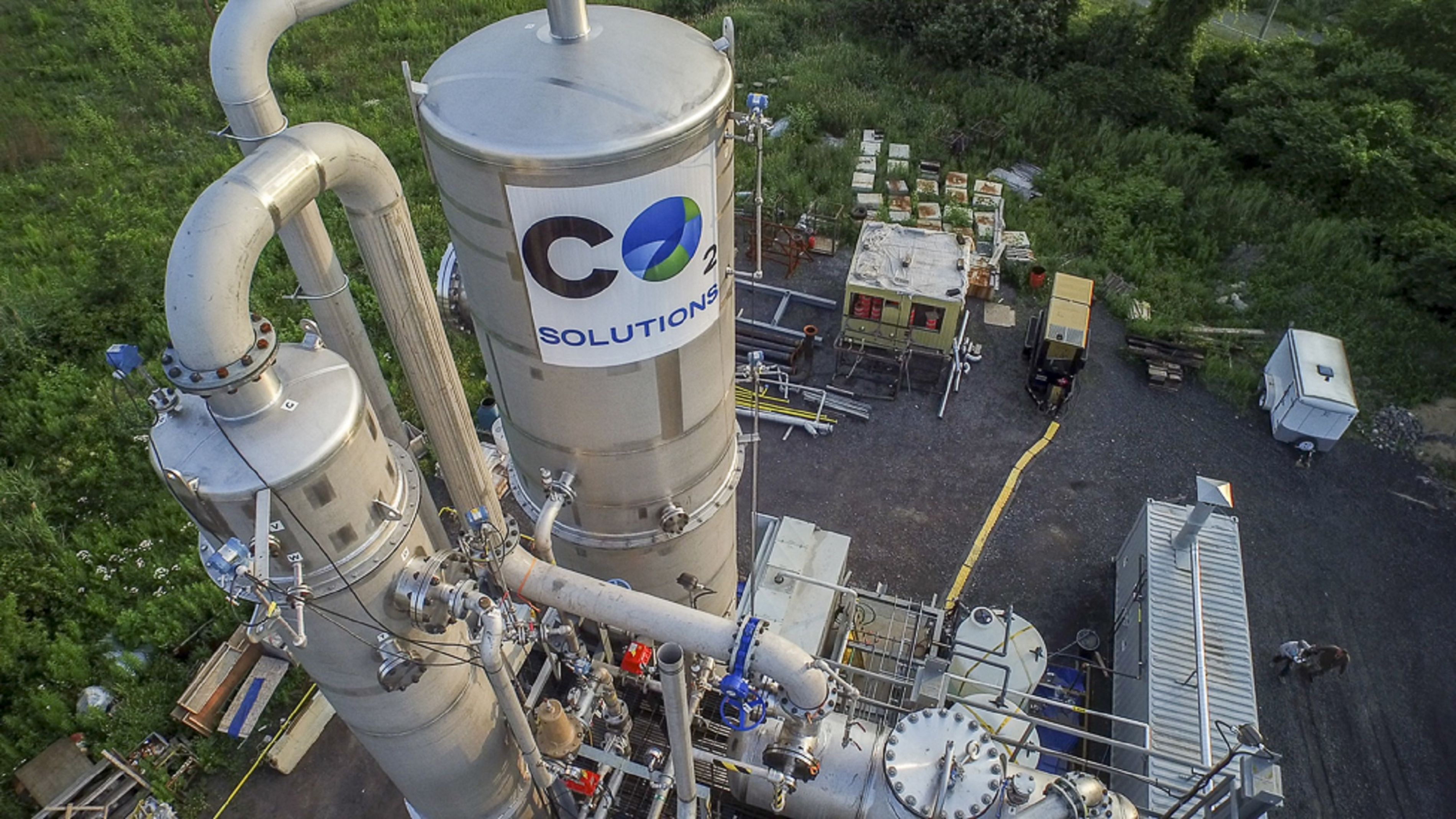Enzymatic Technology for Efficient Carbon Capture from Oil Sands Operations
Lead Proponent: CO2 Solutions Inc.
Location: Québec and Alberta
ecoEII Contribution: $ 5,305,000
Project Total: $ 8,541,000
Project Background
Carbon dioxide (CO2) capture from flue gases has been identified as a mitigation option for reducing greenhouse gas emissions in unconventional oil production. However, owing mainly to the requirement for the use of high temperature steam for solvent regeneration, conventional amine processes for CO2 capture suffer from high costs, on the order of $60 to $90 per metric tonne and even higher. Additionally, amine based solvents suffer from significant environmental and operational issues such as the generation of toxic aerosols and wastes which limit their practical utility and broad application.Inspired by nature, CO2 Solutions’ technology lowers this cost barrier by taking advantage of a powerful naturally occurring enzyme, carbonic anhydrase, which regulates CO2 in all living organisms. This ‘industrial lung’ technology can be retrofitted to existing carbon capture systems as well as installed in new emissions sources.
CO2 Solutions Inc. (CSI) developed an innovative approach to solving the challenges associated with conventional carbon capture technologies. The CSI process is centered on the use of a powerful enzyme catalyst, carbonic anhydrase (CA), which efficiently manages carbon dioxide during respiration in humans and all other living organisms. The CA catalyst provides the opportunity to use energy-efficient, but kinetically-limited solvents such as simple carbonate solutions. These solutions are enzyme-accelerated to provide CO2 absorption kinetics similar to chemical amine solutions. The physical and chemical properties of carbonate solvents allow for the use of low-grade, nil-value heat from the industrial effluent source plant to subsequently strip (break the bond between the solvent and the CO2) the solvent at low temperature (<80°C) to generate a concentrated CO2 stream for sequestration or beneficial reuse. The net result is an ‘industrial lung’ for carbon capture. Recognizing the need for this technology in Alberta’s oil sands and elsewhere, CSI proposed the project “Enzymatic Technology for Efficient Carbon Capture from Oil Sands Operations” for ecoEII funding. The project was awarded $5,305K to optimize and operationally validate CSI’s enzyme-accelerated process for low-cost carbon dioxide capture from flue gas emissions.
Results

CO2 Solutions’ carbon capture unit in Salaberry-de-Valleyfield, Québec
CSI first identified the best solvent and enzyme management processes to test in an existing state-of-the-art ~0.5 tonnes-CO2 per day (tpd) bench-scale CO2 capture unit. Over 200 potential low-energy CO2 capture solvents were screened and tested. It was confirmed that carbonates in general, and potassium carbonate more specifically, offer excellent chemical stability and physical properties for CO2 capture when combined with CA. The best enzyme management process was determined to be the use of soluble enzyme in the simplest process configuration possible where the enzyme flows along with the solvent. Results were used to assess process performance, establish a complete design and perform techno-economic analysis. The technology was then ready to be tested at a larger scale.In the project, CO2 Solutions and its partners will optimize and validate the technology at large-bench and pilot scale to capture 90% of CO2 from oil sands in-situ production and upgrading operations with at least 25% cost savings compared to conventional carbon capture technology. Achieving this objective would provide an efficient solution when integrated with sequestration of the CO2 to help meet Canada’s GHG reduction targets.
A 10tpd demonstration plant was successfully commissioned in Salaberry-de-Valleyfield, Quebec. The plant was designed to capture approximately 90% of the CO2 from the combustion gases of an on-site natural gas fired boiler. The demonstration unit operated from May to October 2015 (more than 2,500 hours). CO2 capture rates of between 65% and 95% were demonstrated. After an initial start-up and stabilization period, the system operated largely autonomously. To maintain CO2 capture, only about a quarter of the CA concentration in the solvent was needed compared to the design value. The CA remaining in the solvent maintained excellent activity throughout the test period and additional enzyme was easily added when needed during operation. The solvent did not show any significant degradation, and no solvent make-up was required during the demonstration period. A CO2 stream with a purity of over 99.95% was produced. This level of purity is suitable for food and beverage use with modest post-treatment. Additionally, no toxic aerosols were produced, no solvent degradation products were observed and the spent solvent was sent directly to the municipal sewer without the need for special treatment. A techno-economic analysis determined the cost to be $28 per tonne of CO2 captured.
Benefits to Canada
The first demonstration of the technology at 10 tpd has been successfully completed. With more projects in the pipeline, commercial deployment of the CSI technology at a larger scale and over a longer term will open the door for major reductions in Canada’s GHG emissions across a wide number of industries (including oil sands, cement, metals, pulp and paper and others), thereby supporting Canada in achieving its stated GHG reduction targets.
Project Status
The technology is ready for commercial deployment. Plans for a 30 tpd system at a greenhouse operation in Quebec and another of up to 300 tpd in Alberta are underway. CSI is also working to deploy the technology for utilizing low-cost, high-purity CO2 as a feedstock to produce value-added products such as fuels, chemicals and plastics.
Page details
- Date modified: